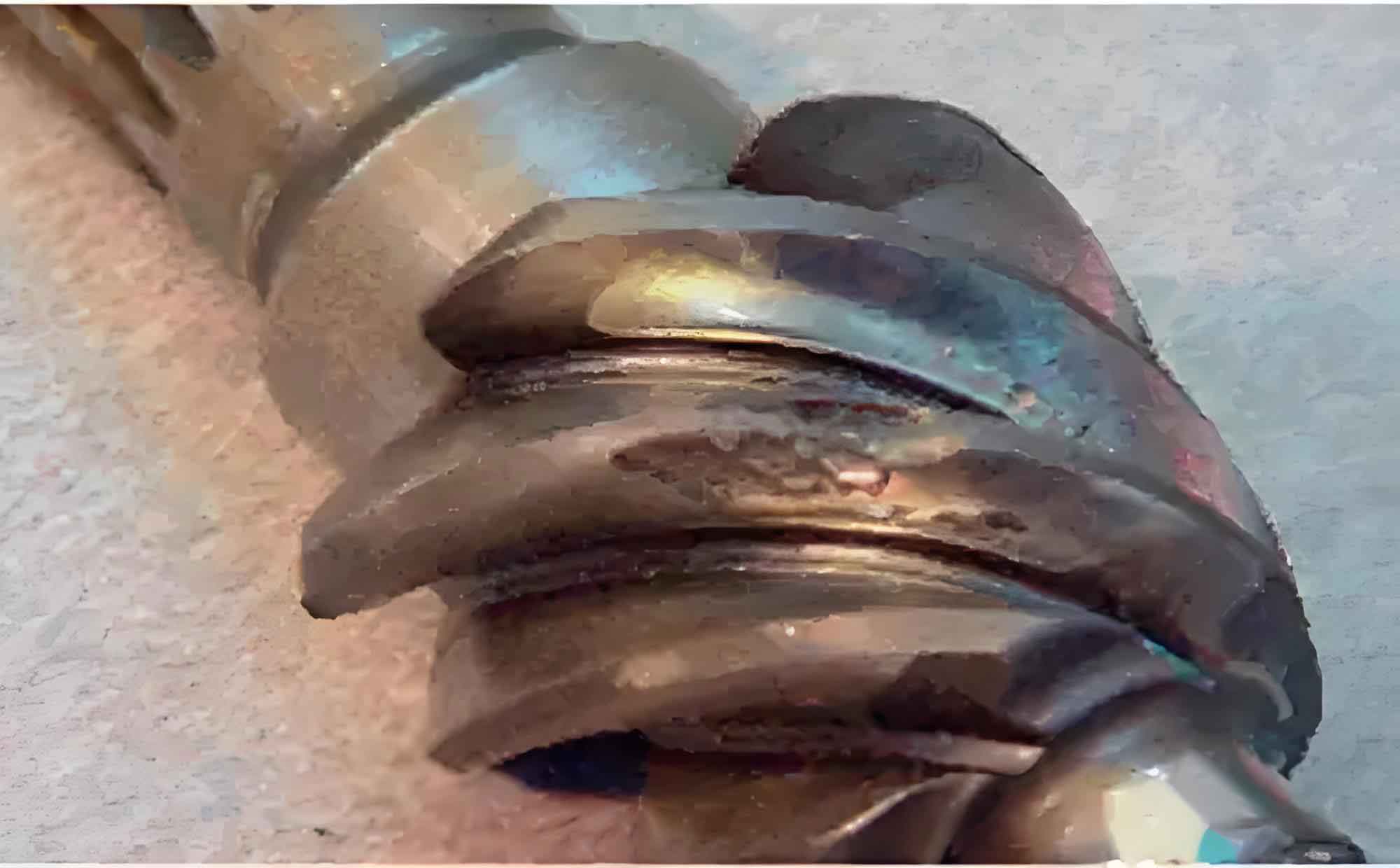Shearer gears operate under extreme conditions in underground coal mining. During final inspection of disk-shaped gears for an EC710 shearer (rated capacity: 528 t/h), surface grinding cracks were detected. Given the severe economic impact of in-mine repairs, comprehensive failure analysis was performed on the affected batch.
Failure Background

Cracks measuring 4–8 mm appeared at tooth roots after magnetic particle inspection (GB/T 15822.1-2005). Key observations:
- Parallel cracking perpendicular to grinding direction
- Black oxidation zones co-located with grinding cracks
- Macroscopic characteristics suggesting thermal origin
Manufacturing process sequence: Forging → Normalizing → Rough machining → Carburizing (920°C) → Quenching → Low-temp tempering (200°C) → Grinding → Shot peening.
Material Composition Examination
Chemical analysis (GB/T 4336-2002) of 25CrMo steel:
| Element | Surface (wt%) | Core (wt%) | Standard (GB/T 3077-2015) |
|---|---|---|---|
| C | 1.03 | 0.27 | 0.22–0.29 (core) |
| Cr | 1.16 | 1.14 | 0.90–1.20 |
| Mn | 0.85 | 0.86 | 0.60–0.90 |
| Mo | 0.24 | 0.21 | 0.15–0.30 |
| Si | 0.35 | 0.32 | 0.17–0.37 |
Compliance confirmed with no segregation detected.
Microstructural Examination
Microstructure analysis (GB/T 13298-2015, GB/T 25744-2010):
| Location | Microstructure | Rating |
|---|---|---|
| Normal zone (surface) | Martensite + retained austenite | Grade 2 |
| Normal zone (core) | Low-carbon martensite + free ferrite | Grade 3 |
| Oxidized zone (surface) | Tempered troostite + spheroidized carbides | N/A |
Critical observations in grinding crack zones:
- Microstructural evidence of tempering (carbide precipitation)
- Crack propagation morphology: Y-shaped branching (depth: 1.68 mm)
- Thermal influence limited to surface layers
Hardness Gradient Analysis
Vickers hardness profiles (GB/T 9450-2005, load: 9.8 N):
Effective case depth calculation:
$$ \text{CHD} = d_{550 \text{HV}} $$
where \(d_{550 \text{HV}}\) is depth where hardness reaches 550 HV.
| Zone | Surface Hardness (HV) | Effective Case Depth (mm) | Core Hardness (HV) |
|---|---|---|---|
| Normal | 698 | 2.30 | 380 |
| Oxidized | 450 | 2.20 | 375 |
Hardness anomaly in oxidized zones:
$$ \Delta H = H_{\text{normal}} – H_{\text{oxidized}} = 248 \text{ HV} $$
indicating significant thermal softening.
Thermo-Mechanical Analysis of Grinding Cracks
Grinding cracks originated through synergistic mechanisms:
1. Thermal Shock Stress:
$$ \sigma_{\text{thermal}} = E \alpha \Delta T $$
where \(E\) = Young’s modulus (210 GPa), \(\alpha\) = thermal expansion coefficient (12.5 × 10⁻⁶/°C), \(\Delta T\) ≈ 600°C (estimated).
2. Phase Transformation Stress:
$$ \Delta V = \left( \frac{V_{\gamma} – V_{\alpha’}}{V_{\gamma}} \right) \approx 4\% $$
Austenite (γ) to martensite (α’) transformation during requenching generates tensile stress.
3. Residual Stress Superposition:
$$ \sigma_{\text{total}} = \sigma_{\text{thermal}} + \sigma_{\text{phase}} + \sigma_{\text{residual}} $$
When \(\sigma_{\text{total}} > \sigma_{\text{UTS}}\) (material ultimate tensile strength), grinding cracks initiate.
Root Cause Identification
Primary factors inducing grinding cracks:
- Excessive grinding heat generation:
- Temperature > Ac1 (≈750°C)
- Localized austenitization
- Insufficient cooling:
$$ \dot{q}_{\text{cooling}} < \dot{q}_{\text{generation}} $$ - Original grinding parameters:
- Depth of cut: 0.08 mm/pass
- Al2O3 grinding wheel (high friability)
Corrective Measures and Validation
Implemented solutions for grinding crack mitigation:
| Parameter | Original | Optimized | Effect |
|---|---|---|---|
| Abrasive type | Brown alumina | White alumina | ↓ Heat generation by 35% |
| Depth of cut | 0.08 mm/pass | 0.04 mm/pass | ↓ Grinding force by 50% |
| Stress relief | None | 160°C × 72h | ↓ Residual stress by 40% |
Validation results after optimization:
- 0 grinding cracks in subsequent 150 gear batches
- Surface hardness consistency: ΔHV < 30
- Microstructural uniformity confirmed
Conclusions
- Grinding cracks exhibited perpendicular orientation to grinding direction with associated oxidation zones
- Thermal softening in affected regions (ΔHV ≈ 250) confirmed microstructural degradation
- The fundamental mechanism involves combined thermal and transformation stresses:
$$ \sigma_{\text{total}} = E \alpha \Delta T + K \Delta V + \sigma_R $$ - Process optimization successfully eliminated grinding cracks through:
- Abrasive system modification
- Reduced grinding aggression
- Pre-grinding stress relief
This systematic approach provides a general framework for preventing grinding cracks in high-performance gears subjected to abusive machining conditions.
